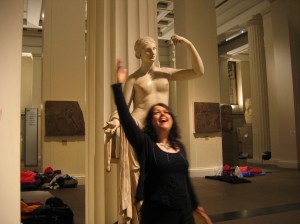Becoming invisible
My aim when telling a story is to become invisible, so that the listener can see the characters and images, and enter the emotions of the story. But paradoxically, becoming invisible doesn’t happen by doing nothing, it demands huge physical and energetic work, and conscious choices about every moment. I am very interested in how using gestures can help images come alive in the audience’s imagination. Gesture can transform the performer and the space around them, and transport the listener into the world of the story.
If you want to explore using gesture in your storytelling, you need to choose who is making the gesture:
The narrator – describing, showing, relating.
A character – doing, saying, feeling.
The commentator – making an aside, commenting.
My starting point is the visual world of the story, and the images, senses and emotions aroused by the narrative. Break the story down, scene by scene and explore how you can use gesture to become characters, reveal locations, conjure emotions. Gestures can be tiny, large, stylized, expressive, mimetic. They can be made by fingertips, incorporate the whole body, or use different levels in space. You might explore the use of rhythm, repetition, symmetry, opposites, asymmetry. But it is essential to be able to find, and re-find a neutral state, so that you can move with absolute clarity between roles and gestures.
The storyteller is playing many roles in a performance and different gestures have different effects. Gestures can: make a relationship; illustrate or describe; suggest or evoke; comment or make an aside. If a gesture is descriptive there needs to be a visual accordance between the gesture and the world being described. So if I am making the gesture of putting a baby in a basket, I need to know what size the baby is, and where the basket is in space. If the gesture doesn’t look convincing then it can undermine the story, and the audience see more of me and less of the image. When I am being the narrator I might use more generalised gesture, but when I am being a character I will need to find specific gestures that evoke who the character is and what they are doing. All this takes creative choices, control and practise.
You can draw on the stylized vocabulary that already exists in many forms of dance. I am inspired by looking at paintings and sculptures. I watch how people use gestures in everyday life – politicians are especially interesting and surprisingly expressive! But watching dancers is the most inspiring of all, and I can only wish!
How the storyteller uses voice, language, space, dialogue, description, humour, pauses … all help them become invisible. I will write about these things another time!


Jamie
This is a great posting, Pomme.
I’d like to take issue with one point.
While it’s surely true that in some works of art and some art forms the artist is invisible, sometimes figuratively as you suggest here, and sometimes literally,
this does not happen, for me, in performance storytelling.
For me, the magic lies precisely in the fact that the storyteller is very much in evidence and, at the same time, somehow, the story is equally present.
In bad storytelling, yes, the presence of the storyteller distracts from the story, or the storyteller comes between story and listener. In good storytelling, somehow the storyteller’s presence nourishes the story.
The closest analogy I can think of is with fine art, in those figurative paintings where the artist at once draws attention to the materiality of the paint while simultaneously using the paint to discover something that no-one else has seen in the objects painted.
Sally Clayton
Jamie! What wonderful true words. You add such richness and truth too. You are absolutely right. Of course it is all so hard to do. And when it is good it looks so easy!
Coilín "The Oh-Aissieux"
Thanks for this very insightful essay on the significance of gesture in storytelling, Sally.
The more I perform and develop as a storyteller, the more I see my art as a form of dance, with a few words spoken to lead the audience along with me.